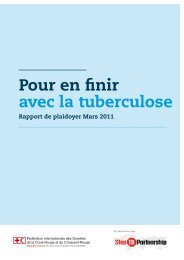Thailand - Stop TB Partnership
Thailand - Stop TB Partnership
Thailand - Stop TB Partnership
You also want an ePaper? Increase the reach of your titles
YUMPU automatically turns print PDFs into web optimized ePapers that Google loves.
Background<br />
Baseline statistics<br />
<strong>Thailand</strong> has experienced rapid economic growth in the past few decades. Its average economic<br />
growth rate was 5.4 percent a year from 1975 to 2001. 1 By 2002, its GDP per capita<br />
had reached $2,060 (78,286 baht). By 2004, <strong>Thailand</strong> was widely considered a “middle<br />
income country.” 2<br />
Increasing prosperity has been matched by increased government expenditure on<br />
health. Health expenditures rose from 3.5 percent of GDP in 1979 to 6.1 percent in 2000, 3<br />
and the country has experienced significant improvements in health and other social indicators.<br />
For example, in the period from 1960 to 2005, the infant mortality rate decreased from<br />
84.3 to 17.3 per 1,000 live births; 4 by 2002, the adult literacy rate was 92.6 percent.<br />
In this broader context of socioeconomic development and increased investment<br />
in health, the National Tuberculosis Programme (NTP) succeeded in reducing <strong>TB</strong> incidence<br />
by 50 percent in six years, from 150 cases per 100,000 people in 1985—a record for<br />
the country—to 76 per 100,000 in 1991. 5 However, <strong>TB</strong> incidence rose again in the 1990s<br />
with the emergence of the HIV/AIDS epidemic, 6 and the deadly interaction of <strong>TB</strong> and HIV<br />
brought new challenges to <strong>TB</strong> control efforts. With an estimated annual <strong>TB</strong> incidence of<br />
142 per 100,000, <strong>Thailand</strong> is 18th on the World Health Organization’s (WHO’s) list of<br />
<strong>TB</strong> high-burden countries. 7 Experts have noted, however, that national estimates may be<br />
compromised by the fact that a comprehensive survey to estimate incidence has not been<br />
conducted in over 15 years. 8<br />
<strong>TB</strong>/HIV and multidrug-resistant <strong>TB</strong><br />
The estimated prevalence of HIV in <strong>Thailand</strong> is among the highest in Southeast Asia, with<br />
an infection rate of 1.5 percent among adults aged 15–49. 9 Sentinel surveys, which are based<br />
on data gathered at selected clinics and hospitals, indicate that HIV prevalence among <strong>TB</strong><br />
patients ranges from 10 to 15 percent countrywide, but may reach 40 percent in the north. 10<br />
According to a statement by Deputy Minister of Public Health Anutin Charnvirakul, about<br />
one-third of people living with HIV also have <strong>TB</strong>—approximately 12 times higher than the<br />
rate among people who do not have HIV. 11<br />
Such high rates of <strong>TB</strong>/HIV coinfection are alarming, especially since the diagnosis<br />
and treatment of <strong>TB</strong> in people who are also HIV-positive is a challenge. Many HIV-positive<br />
patients either have sputum smear-negative or extrapulmonary <strong>TB</strong>, which are not detected<br />
38<br />
<strong>TB</strong> POLICY IN THAILAND



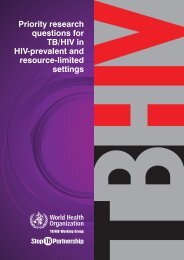
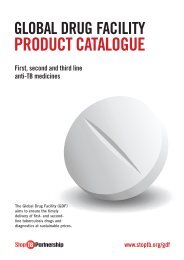
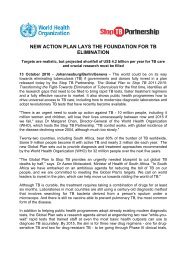
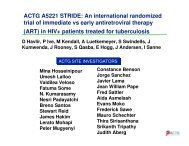
![Global Drug Facility Annual Report 2011 [.pdf] - Stop TB Partnership](https://img.yumpu.com/26788745/1/184x260/global-drug-facility-annual-report-2011-pdf-stop-tb-partnership.jpg?quality=85)

![Concept note on national stop TB partnership [.pdf]](https://img.yumpu.com/26788741/1/184x260/concept-note-on-national-stop-tb-partnership-pdf.jpg?quality=85)
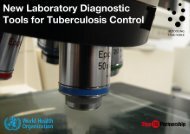

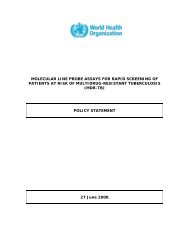
![2005 and Challenges for 2006 - 2015 [.pdf] - Stop TB Partnership](https://img.yumpu.com/26788674/1/190x245/2005-and-challenges-for-2006-2015-pdf-stop-tb-partnership.jpg?quality=85)
![Brochure (French) [.pdf] - Stop TB Partnership](https://img.yumpu.com/17234792/1/190x91/brochure-french-pdf-stop-tb-partnership.jpg?quality=85)

